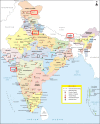A survey of canine filarial diseases of veterinary and public health significance in India
- PMID: 20377864
- PMCID: PMC2857864
- DOI: 10.1186/1756-3305-3-30
A survey of canine filarial diseases of veterinary and public health significance in India
Abstract
Background: Dirofilaria spp., Acanthocheilonema spp. and Brugia spp. have all been reported in Indian dogs. In previous studies, diagnosis was made by morphological identification only. This is the first geographically stratified cross-sectional study in India to determine the prevalence and geographical distribution of canine filarial species of veterinary and public health importance, using a combination of conventional and molecular diagnostic techniques.
Results: A total of 139 from 525 dogs (26.5%; 95% CI 22.7, 30.3) were positive for microfilariae. The most common species of canine filaria identified in this study was A. reconditum (9.3%) followed by D. repens (6.7%) and D. immitis (1.5%). Three out of 525 dogs were found to have mixed infections on PCR. The morphological and molecular evidence on the sequence of the 18S gene and phylogenetic analysis of the ITS-2 region provided strong evidence that the canine microfilariae discovered in the Himalayan city of Ladakh belong to a novel species of Acanthocheilonema. Two dogs in Ladakh were also found to have mixed infections of the novel species described above and a unique microfilaria which morphologically resembled Microfilaria auquieri Foley, 1921.
Conclusions: At least six species of filarial nematode are now known to infect dogs in India, two of which were reported for the first time in this study. The study also confirms and extends the geographical distribution of canine heartworm (D. immitis) which overlaps with D. repens, emphasising the importance for veterinary clinicians and diagnostic laboratories to utilise immunodiagnostic tests that will not cross-react between those two filarial species. From a public health viewpoint, the distribution and prevalences of these nematodes warrant an appropriate prophylaxis to be administered to dogs.
Figures





References
-
- Macpherson CN, Meslin FX, Wandeler AI. Dogs, Zoonoses and Public Health. Anthony Rowe Limited, Eastbourne; 2000.
-
- Grieve RB, Lok JB, Glickman LT. Epidemiology of canine heartworm infection. Epidemiol Rev. 1983;5:220–246. - PubMed
-
- Kuecks RW, Slocombe JOD. In: Proceedings of the Heartworm Symposium; 23-24 February 1980; Dallas, Texas. Otto GF, editor. 1980. Rapid histochemical differentiation of Dirofilaria immitis and Dipetalonema reconditum; pp. 48–50.
-
- Peribanez MA, Lucientes J, Arce S, Morales M, Castillo JA, Gracia MJ. Histochemical differentiation of Dirofilaria immitis, Dirofilaria repens and Acanthocheilonema dracunculoides microfilariae by staining with a commercial kit, Leucognost-SP (R) Vet Parasitol. 2001;102:173–175. doi: 10.1016/S0304-4017(01)00516-7. - DOI - PubMed
LinkOut - more resources
Full Text Sources
Miscellaneous

